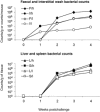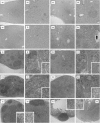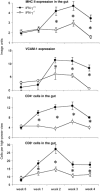Interferon-gamma plays a critical role in intestinal immunity against Salmonella typhimurium infection
- PMID: 10712678
- PMCID: PMC2327174
- DOI: 10.1046/j.1365-2567.2000.00955.x
Interferon-gamma plays a critical role in intestinal immunity against Salmonella typhimurium infection
Abstract
Salmonella bacteria are a major cause of food-borne infectious diarrhoea and there is great interest in understanding the pathogenesis of Salmonella infection and in vaccine development. Potential vaccines include the aromatic mutants of S. typhimurium. Such non-lethal Aro mutants have also been useful for studying Salmonella infections in mouse models. Studies of systemic infection, using these Aro mutants, in both normal and cytokine gene knockout mice, indicate that interferon-gamma (IFN-gamma) plays a key role in the resolution of Salmonella infection. The present studies have investigated the outcome of oral infection in mice with attenuated Salmonella because this infection route mimics natural infection in humans. In IFN-gamma gene knockout (IFN-gamma-/-) mice, intestinal immunity was impaired and oral challenge resulted in disseminated septicaemia 2 weeks later. No dissemination of infection was seen in wild-type mice. In wild-type mice, both CD4 and CD8 cell numbers increased in the gut following Salmonella challenge, together with increased expression of major histocompatibility complex (MHC) II and vascular cell adhesion molecule-1 (VCAM-1). No such changes were seen in IFNgamma-/- mice. Following oral challenge, antilipopolysaccharide (LPS) and antiphosphoryl choline antibodies increased by more than 100-fold in both serum and faecal pellet extracts of IFNgamma-/- mice compared with wild-type mice. Our data show that IFN-gamma production is essential for resolution of enteric Salmonella infection and that antibody has little effect on this process.
Figures





References
-
- Hoiseth SK, Stocker BA. Aromatic-dependent Salmonella typhimurium are non-virulent and effective as live vaccines. Nature. 1981;291:238. - PubMed
-
- Ramarathinam L, Shaban RA, Niesel DW, Klimpel GR. Interferon gamma (IFN- gamma) production by gut-associated lymphoid tissue and spleen following oral Salmonella typhimurium challenge. Microb Pathog. 1991;11:347. - PubMed
-
- Kiderlen AF, Kaufmann SH, Lohmann-matthes ML. Protection of mice against the intracellular bacterium Listeria monocytogenes by recombinant immune interferon. Eur J Immunol. 1984;14:964. - PubMed
Publication types
MeSH terms
Substances
LinkOut - more resources
Full Text Sources
Molecular Biology Databases
Research Materials
Miscellaneous

